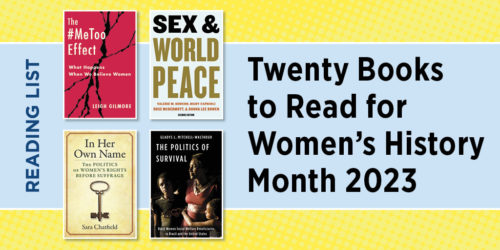From Shameful to Sexy — Kelly Oliver on Changing Representations of Pregnancy

“Pregnancy and pregnant bodies have gone from shameful and hidden to sexy and spectacular”—Kelly Oliver
In From Shameful to Sexy, the introduction to Knock Me Up, Knock Me Down: Images of Pregnancy in Hollywood Films , Kelly Oliver examines the shifting image of the pregnant woman in popular culture and Hollywood films.
She argues that this phenomenon has taken pregnancy out of the closet, it also creates unrealistic expectations for women to have it all. It also reflects ambivalent attitudes toward women’s roles and traditional family values, and new technologies of reproduction.
Here is an excerpt from the introduction:
Pregnancy has become an obsession in popular culture where paparazzi are constantly on the lookout for celebrities’ telltale “baby bumps” and heavily pregnant bellies, and reality television shows and tabloid magazines parade teen pregnancies, sexy “momshells,” and celebrity baby woes and triumphs. Pregnancy and pregnant bodies have gone from shameful and hidden to sexy and spectacular….
Certainly, positive and desirable images of pregnant women are a step forward. But if we look closer, we can see how these seemingly new stories repeat traditional ideas about abject maternal bodies, conventional notions of family values, familiar anxieties over women’s role in reproduction, and fears of miscegenation. In addition, current ideals that promote pregnancy and maternity as desirable, especially for career women, bring new expectations that often require heroic efforts and large doses of caffeine, antidepressants, and sleeping pills—not to mention Mama Spanx maternity wear, “mommy-tucks,” diet fads, and taxing workouts at the gym. Today, women are not only responsible for the health and welfare of their babies but also expected to stay beautiful and fit while pregnant and to lose their “baby fat” as soon as possible in order to “get their bodies back” (as one tabloid put it, suggesting that their pregnant bodies are not their real bodies). Pregnancy has become like an accessory worn by the rich and famous, an adornment that can be removed. Pregnant celebrities go from lack to excess and back again, from anorexic to sporting the telltale “baby bump,” so popular in the media. Now, rather than laying in or staying at home, pregnant women are expected to exercise, continue working, and still be beautiful and sexy for their male partners. In the words of Wenda Wardell Morrone, “We can all recognize the successful pregnant working woman: she is the one in the maternity jogging suit running a marathon on her way to chairing a business meeting; she’ll give birth in her lunch hour without even smudging her eye shadow. She is also a fantasy”.
If Hollywood did not create this fantasy, it continues to feed it. Indeed, in recent years Hollywood has helped revive the fantasy of women “having it all”—babies, careers, sexy bodies, and the freedom to enjoy them. Pregnancy has become as desirable as ever, now fueled by images of “knocked-up knockouts,” “momshells,” and pregnant celebrities. Hollywood is giving birth to new images of sexy, cute, and attractive pregnancies offscreen and on….
Even though the myth of “having it all” is still alive and well, as evidenced by these Hollywood films in which career women get babies, find “the one,” remain sexy, and apparently live happily ever after, real women continue to grapple with how to juggle career and family in the face of ever-shrinking social services and support. Hollywood attempts to quell these anxieties with reassuring tales of white career women getting babies before it’s too late and of girls and women turning unwanted pregnancies into wanted babies. Or it terrorizes us with horror and sci-fi fantasies in which abject monstrous hybrid offspring—usually the result of technological mediation and human hubris—threaten the end of the human race as we know it. In either case, Hollywood’s recent fascination with pregnancy displays continued anxieties about women’s role in reproduction and continued ambivalence about pregnant embodiment. Even as Hollywood films present pregnant bodies in ways unimaginable only a couple of decades ago, they continue to picture conventional attitudes toward women, pregnancy, and childbirth. Even while they attempt to grapple with new reproductive technologies and women’s expanding choices regarding reproduction, they manifest fears and anxieties that surround them.
Although recent Hollywood films show us some of the difficulties of reproductive choice, they usually end with resolutions that cover over, if not openly disavow, the ambiguities of women’s desires and freedoms. For the most part, they do not engage the complexities of reproductive freedom in a culture where women’s value is still seen, at least in part, in terms of having and raising babies. Although the debates over motherhood and feminism have changed—with Sarah Palin we supposedly have a new brand of “rogue feminism”—the culture that inspires them has not changed as dramatically as we might think. If pregnant Hollywood films are any indication, above all, women are still expected to reproduce, only now they are also expected to freely choose to do so and to do it the old-fashioned way lest they risk giving birth to monsters. If they do give birth to monsters, they are expected to love them anyway with the ferocity of the mother-love that any female should feel, whether human or animal. Like most women expecting babies, however, Hollywood prefers that their offspring have ten (human) fingers and ten (human) toes. But even if they don’t, the little monsters provide good entertainment by giving life to latent desires and fears, both old and new. In spite of their tendency to simplify and resolve the ambiguities and ambivalences of women’s choices about issues of motherhood, sexuality, and pregnancy, recent Hollywood films also show us characters struggling with them. Pregnancy films show us women refusing the either/or of traditions that make them choose career over family and relationships. Today, questions of family and career are no longer necessarily simple either/or choices. Beyond the myth of “having it all,” (middle-class) women are trying to figure out how to have both/and. Even as they create new myths of “having it all,” recent Hollywood pregnancy films also display deep-seated anxieties about women’s reproductive choices and the “accident” that is pregnancy in an age of changing technologies.







1 Response